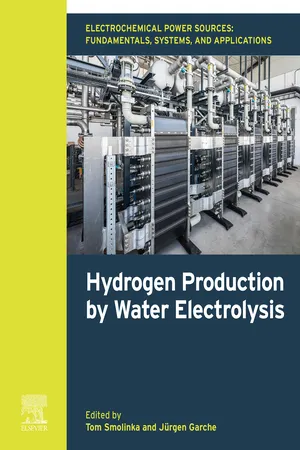
Electrochemical Power Sources: Fundamentals, Systems, and Applications
Hydrogen Production by Water Electrolysis
- 512 pages
- English
- ePUB (mobile friendly)
- Available on iOS & Android
Electrochemical Power Sources: Fundamentals, Systems, and Applications
Hydrogen Production by Water Electrolysis
About This Book
Electrochemical Power Sources: Fundamentals, Systems, and Applications: Hydrogen Production by Water Electrolysis offers a comprehensive overview about different hydrogen production technologies, including their technical features, development stage, recent advances, and technical and economic issues of system integration. Allied processes such as regenerative fuel cells and sea water electrolysis are also covered. For many years hydrogen production by water electrolysis was of minor importance, but research and development in the field has increased significantly in recent years, and a comprehensive overview is missing. This book bridges this gap and provides a general reference to the topic.Hydrogen production by water electrolysis is the main technology to integrate high shares of electricity from renewable energy sources and balance out the supply and demand match in the energy system. Different electrochemical approaches exist to produce hydrogen from RES (Renewable Energy Sources).
- Covers the fundamentals of hydrogen production by water electrolysis
- Reviews all relevant technologies comprehensively
- Outlines important technical and economic issues of system integration
- Includes commercial examples and demonstrates electrolyzer projects
Frequently asked questions
Information
Table of contents
- Cover Image
- Title Page
- Copyright
- Table of Contents
- Contributors
- Chapter 1 The importance of water electrolysis for our future energy system
- Chapter 2 Fundamentals of water electrolysis
- Chapter 3 Thermochemical hydrogen processes
- Chapter 4 The history of water electrolysis from its beginnings to the present
- Chapter 5 Alkaline electrolysis—status and prospects
- Chapter 6 PEM water electrolysis
- Chapter 7 High temperature steam electrolysis
- Chapter 8 Chlor–alkali electrolysis
- Chapter 9 Seawater electrolysis
- Chapter 10 Economic considerations for hydrogen production with a focus on polymer electrolyte membrane electrolysis
- Chapter 11 Regenerative fuel cells
- Chapter 12 New electrolyzer principles: decoupled water splitting
- Chapter 13 Hydrogen storage
- Index